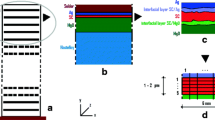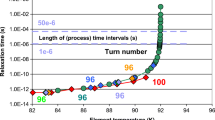Abstract
The stability behaviour of a thin-film superconductor under a localized release of thermal disturbance is investigated. Two-dimensional conjugate film/substrate conduction equation with anisotropic thermal conductivity of the film, and Joule heat are employed to investigate effects of substrate and thermal properties on the intrinsic stability and quenching recovery. To consider the thermal boundary resistance between film and substrate, an interfacial-layer model (ILM) with very low diffusivity and an acoustic mismatch model (AMM) are employed. Results show that the thermal boundary resistance influences strongly the intrinsic stability. Thermal boundary resistance increases intrinsic stability if the thermal conductivity of the substrate or the disturbance energy is large. Higher Biot numbers and thermal conductivity ratios of film to substrate in longitudinal direction influence stability favorably. We demonstrate also that operation of a film/substrate system, such as YBCO/MgO, is either intrinsically stable or irrecoverably unstable.
Similar content being viewed by others
Abbreviations
- a :
-
Half superconductor width (m)
- A :
-
Non-dimensional width
- A r :
-
Aspect ratio,a/d f (dimensionless)
- Bi :
-
Biot number (dimensionless)
- c :
-
Specific heat (J (kg K)−1)
- d :
-
Thickness (m)
- D :
-
Non-dimensional substrate thickness
- e d :
-
Thermal energy released per unit length (J m−1)
- E d :
-
Non-dimensional thermal energy released,e d/2ρf[C f(T c−T o)ad f]
- h :
-
Convective heat transfer coefficient (W m−2 K−1)
- h :
-
Planck's constant=6.6262×10−34 J s
- J :
-
Current density (A m−2)
- J r :
-
Current density ratio,J o/J co (dimensionless)
- (J r)c :
-
Critical current density ratio at the point where (J r)c1=(J r)C2
- (J r)c1 :
-
Critical current density ratio for intrinsic stability (dimensionless)
- (J r)c2 :
-
Critical current density ratio for recovery (dimensionless)
- k :
-
Thermal conductivity (W m K−1)
- k B :
-
Boltzmann constant= 1.38062×10−23 J K−1
- K :
-
Non-dimensional thermal conductivity
- K fs :
-
Ratio of thermal conductivity,k fx/k s
- K r :
-
Ratio of thermal conductivity,k fy/k fx
- K :
-
Thermal conductivity tensor
- q :
-
Heat rate per unit length (W m−1)
- q b :
-
Boundary heat flux
- Q b :
-
Non-dimensional boundary heat flux
- Q rs :
-
Ratio of heat generation rate to heat rate brought out from film,q g/(q cv+q cs)
- r d :
-
Thickness ratio of interfacial layer to film
- r k :
-
Thermal conductivity ratio of interfacial layer to film
- R bd :
-
Thermal boundary resistance
- T :
-
Temperature (K)
- t :
-
Time (s)
- v :
-
Sound velocity (m s−1)
- x, y :
-
Cartesian coordinate
- X, Y :
-
Transformed dimensionless coordinate
- α:
-
Thermal diffusivity (m2 s−1)
- Γ:
-
Constant; see Eq. (12)
- ϕ:
-
Instability parameter (dimensionless)
- κ:
-
Constant; see Eq. (12)
- θ:
-
Non-dimensional temperature, (T- T 0 T c-T 0)
- ϱ:
-
Density (kg m−3)
- σ:
-
Normal state electrical resistivity (Ω m)
- τ:
-
Non-dimensional time,k fy t/(d 2ϱC)f
- 1, 2:
-
Point of intrinsic thermal stability failure and recovery, respectively
- c :
-
Critical
- co :
-
Critical operation
- cv :
-
Convection by coolant
- cs :
-
Conduction by substrate
- f :
-
Film
- l :
-
Interfacial layer
- max:
-
Maximum
- o :
-
Operating
- r :
-
Ratio
- s :
-
Substrate
- x, y :
-
Inx, y direction
References
M. N. Wilson, Superconducting magnets. Clarendon Press, Oxford, UK 1983.
M. I. Flik and C. L. Tien, ASME J. Heat Transfer, 112 (1990) 10.
M. Wetzko, M. Zahn and H. Reiss, Cryogenics, 35 (1995) 375.
S. K. Streiffer, B. M. Lairson, C. B. Eom, B. M. Clemens, J. C. Bravman and T. H. Geballe, Phys. Rev. B, 43 (1991) 13007.
E. T. Swartz and R. O. Pohl, Rev. Mod. Phys., 61 (1989) 605.
C. D. Marshall, I. M. Fishman, R. C. Dorfman, C. B. Eom and M. D. Fayer, Phys. Rev. B, 45 (1992) 10009.
W. A. Little, Can. J. Phys., 37 (1959) 334.
M. Nahum, S. Verghese and P. L. Richards, Appl. Phys. Lett., 59 (1991) 2034.
R. C. Chen, J. P. Wu and H. S. Chu, ASME J. Heat Transfer, 117 (1995) 366.
Z. J. Stekly and J. L. Zar, IEEE Trans. on Nuclear Science, 12 (1965) 367.
L. Dresner, Cryogenics, 16 (1976) 675.
B. Turck, Cryogenics, 20 (1980) 146.
A. Devred, J. Appl. Phys., 67 (1990) 7467.
Z. P. Zhao and Y. Iwasa, Cryogenics, 31 (1991) 817.
S. Y. Seol and M. C. Chyu, Cryogenics, 34 (1994) 521.
R. C. Chen and H. S. Chu, Cryogenics, 31 (1991) 749.
A. Unal and M. C. Chyu, Cryogenics, 34 (1994) 123.
S. Y. Seol and M. C. Chyu, Cryogenics, 34 (1994) 513.
S. J. Hagen, Z. Z. Wang and N. P. Ong, Phys. Rev. B, 40 (1989) 9389.
G. A. Slack, Phys. Rev., 126 (1962) 427.
Y. S. Touloukian and E. H. Buyco, Thermal physical properties of matter Vol. 5. IFI/Plenum, New York 1970.
P. C. Michael, J. U. Trefny and B. Yarar, J. Appl. Phys., 72 (1992) 107.
Author information
Authors and Affiliations
Additional information
The authors wish to express their sincere appreciation to Dr. R. C. Chen for his invaluable advice and suggestions during the course of this paper. This research was supported by the National Science Council of the R. O. C. through grant NSC 83-0401-E-009-006. The computations were performed on the IBM ES/9000 at the National Center For High-Performance Computing.
Rights and permissions
About this article
Cite this article
Wu, J.P., Chu, H.S. Intrinsic thermal stability and quenching recovery of thin-film superconductors with thermal boundary resistance. Journal of Thermal Analysis 48, 951–969 (1997). https://doi.org/10.1007/BF01979145
Issue Date:
DOI: https://doi.org/10.1007/BF01979145




